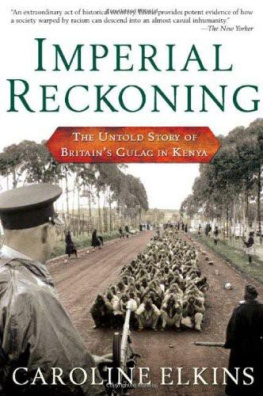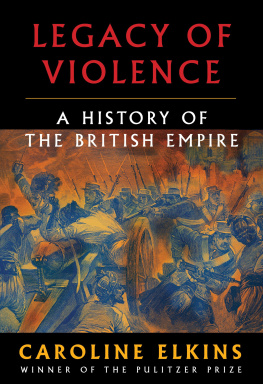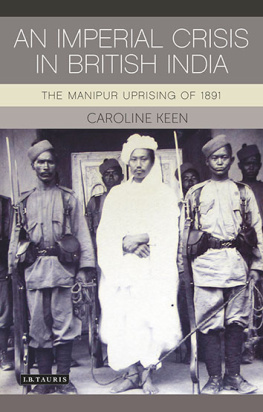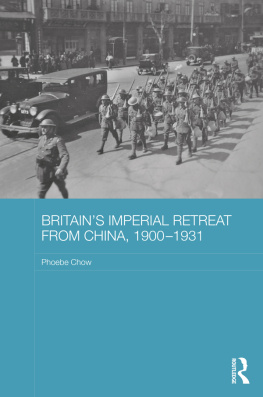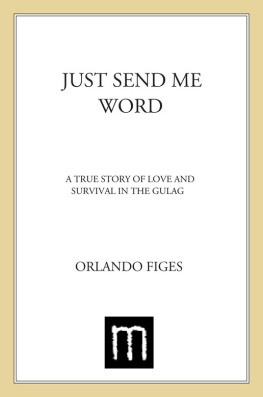Caroline Elkins - Imperial Reckoning: The Untold Story of Britains Gulag in Kenya
Here you can read online Caroline Elkins - Imperial Reckoning: The Untold Story of Britains Gulag in Kenya full text of the book (entire story) in english for free. Download pdf and epub, get meaning, cover and reviews about this ebook. year: 2005, publisher: Owl Books, genre: Politics. Description of the work, (preface) as well as reviews are available. Best literature library LitArk.com created for fans of good reading and offers a wide selection of genres:
Romance novel
Science fiction
Adventure
Detective
Science
History
Home and family
Prose
Art
Politics
Computer
Non-fiction
Religion
Business
Children
Humor
Choose a favorite category and find really read worthwhile books. Enjoy immersion in the world of imagination, feel the emotions of the characters or learn something new for yourself, make an fascinating discovery.
- Book:Imperial Reckoning: The Untold Story of Britains Gulag in Kenya
- Author:
- Publisher:Owl Books
- Genre:
- Year:2005
- Rating:3 / 5
- Favourites:Add to favourites
- Your mark:
- 60
- 1
- 2
- 3
- 4
- 5
Imperial Reckoning: The Untold Story of Britains Gulag in Kenya: summary, description and annotation
We offer to read an annotation, description, summary or preface (depends on what the author of the book "Imperial Reckoning: The Untold Story of Britains Gulag in Kenya" wrote himself). If you haven't found the necessary information about the book — write in the comments, we will try to find it.
Imperial Reckoning: The Untold Story of Britains Gulag in Kenya — read online for free the complete book (whole text) full work
Below is the text of the book, divided by pages. System saving the place of the last page read, allows you to conveniently read the book "Imperial Reckoning: The Untold Story of Britains Gulag in Kenya" online for free, without having to search again every time where you left off. Put a bookmark, and you can go to the page where you finished reading at any time.
Font size:
Interval:
Bookmark:

T O B RENT

LOOKING BACK TO THE START OF MY RESEARCH IN THE SUMMER OF 1995, I had no idea that nearly ten years later I would write a book about wide-scale destruction in colonial Kenya and Britains vigorous attempts to cover it up. I was a Harvard graduate student during those early days and had become fascinated with the history of the Mau Mau uprising, a movement launched by Kenyas largest ethnic group, the Kikuyu, who had been pushed off part of their land in the process of colonization. From the start of the war in October 1952, tales of Mau Mau savagery spread wildly among the white settlers in the colony and at home in Britain. Mau Mau was portrayed as a barbaric, anti-European, and anti-Christian sect that had reverted to tactics of primitive terror to interrupt the British civilizing mission in Kenya.
Mau Mau seized the worlds attention in the early 1950s, not just in Britain and the Commonwealth countries but also in the United States, Western Europe, and the Soviet bloc. Life and other magazines presented photographic spreads with chilling pictorial evidence of Mau Maus savagery that contrasted dramatically with images of the local British settlers. While the Mau Mau insurgents claimed they were fighting for ithaka na wiyathi , or land and freedom, few people in the Western world took seriously the demands of these so-called savages. The Mau Mau were said to be criminals or gangsters bent on terrorizing the local European population, and certainly not freedom fighters.
The British mounted two parallel responses to the rebellion. The first was in the remote mountain forests of Kenya, where security forces engaged in a drawn-out offensive against some twenty thousand Mau Mau guerrilla insurgents. In difficult forest terrain it took over two years and twenty thousand members of Britains military forces, supported by the Royal Air Force, to gain control over the Mau Mau insurgents, who were armed largely with homemade weapons and who had no military or financial support from outside Kenya.
The second and lengthier campaign was directed against a much larger civilian enemy. The British and their African loyalist supporters targeted some 1.5 million Kikuyu who were believed to have taken the Mau Mau oath and had pledged themselves to fight for land and freedom. The battlefield for this war was not the forests but a vast system of detention camps, where colonial officials reportedly held some eighty thousand Kikuyu insurgents.
I couldnt help but find these camps a compelling subject for my dissertation, particularly since no one had written a book about them. So in 1995 I embarked with great interest on the research I would need to do to capture the details of this story. I began with a preliminary sift through the official archives in London, where files stuffed with dusty, yellowed memos and reports told a seductive story about Britains civilizing mission during the last years of colonial rule in Kenya. According to the documents, the detention camps were not meant to punish the rebellious Kikuyu but rather to civilize them. Behind the barbed wire, colonial officials were reportedly giving the detainees civics courses and home-craft classes; they were teaching the insurgents how to be good citizens and thus become capable of running Kenya sometime in the future. The colonial government did report some one-offs, or incidents, as it called them, of brutality against the detainees but insisted they were isolated occurrences. At this early stage in my research, I had little doubt about the story slowly unfolding from Britains official archive. When I presented my dissertation proposal to my department in the winter of 1997, I was intending to write a history of the success of Britains civilizing mission in the detention camps of Kenya.
I soon returned to Britain and then went on to Kenya for an exhaustive look into the official colonial records. It wasnt long before I began questioning my earlier view of the camps and the British colonial government. I found that countless documents pertaining to the detention camps either were missing from Britains Public Record Office and the Kenya National Archives or were still classified as confidential some fifty years after the Mau Mau war. The British were meticulous record keepers in Kenya and elsewhere in their empire, making the absence of documentation on the camps all the more curious. I came to learn that the colonial government had intentionally destroyed many of these missing files in massive bonfires on the eve of its 1963 retreat from Kenya.
To give a sense of the destructive scale, three different departments within the colonial government kept individual files for each of the reported eighty thousand detainees in the camps. This means there should have been at least 240,000 individual detainee files in the official archives. I spent days and days searching for them in the catalogs of Britains coldly efficient Public Record Office and in the dusty but orderly file shelves of the Kenya National Archives, but in the end I unearthed only a few hundred in Nairobi and came up empty-handed in London.
After years of combing through what remains in the official archives, I discovered that there was a pattern to Britains cleansing of the records. Any ministry or department that dealt with the unsavory side of detention was pretty well emptied of its files, whereas those that ostensibly addressed detainee reform, or Britains civilizing mission, were left fairly intact. This was hardly accidental and explains why my first cursory reading of the official files in London generated a picture of a relatively benign system of detention in colonial Kenya.
Even the most assiduous purges, however, often fail to clean up all the incriminating evidence. I spent years going through file upon file of official documents looking for anything that pertained to the detention camps. Some days I found nothing of use; other times I discovered nuggets of information that I added to a growing pile of evidence. It was a tedious and sometimes frustrating process as I struggled simply to identify all of the different campsthere is no single remaining document that lists them alland to reconstruct the chain of colonial authority responsible for their day-to-day operations. Many times I would grow weary of finding little of any use, then hit on a document that provided just another small piece to the puzzle. Mercifully, there were also the handful of days when I would come across entire files filled with rich evidence, files like the ones bursting with letters written by detainees during their time in the camps and addressed to high-ranking colonial officials. In them, the detainees provided vivid accounts of what their lives were like behind the wire, accounts that challenged any notion that the British detention camps were civilizing.
Other revelations in the archives came not from any single document or file but rather from the cumulative effects of sustained research. Over time, I developed a certain sense that told me when something just didnt seem right. For instance, given the sheer number of detainees referenced in the files, the official number of eighty thousand detained began to seem more and more suspicious to me. Upon closer scrutiny it was clear that the British had provided misleading detention numbers, giving daily average figures, or net rather than gross figures. In other words, the official number did not take into account all those detainees who had already entered and exited the camps. By going back through the documents and piecing together the intake and release rates, I determined that the number of Africans detained was at least two times and more likely four times the official figure, or somewhere between 160,000 and 320,000.
Font size:
Interval:
Bookmark:
Similar books «Imperial Reckoning: The Untold Story of Britains Gulag in Kenya»
Look at similar books to Imperial Reckoning: The Untold Story of Britains Gulag in Kenya. We have selected literature similar in name and meaning in the hope of providing readers with more options to find new, interesting, not yet read works.
Discussion, reviews of the book Imperial Reckoning: The Untold Story of Britains Gulag in Kenya and just readers' own opinions. Leave your comments, write what you think about the work, its meaning or the main characters. Specify what exactly you liked and what you didn't like, and why you think so.

